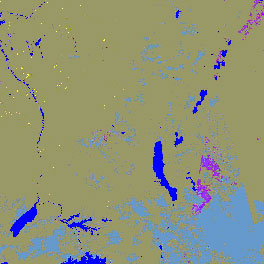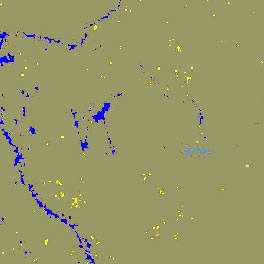EDG Data Set Name
MODIS/Terra Thermal Anomalies/Fire Daily L3 Global 1km ISIN Grid
Granule Shortname
MOD14A1
Data Set Characteristics
Area = ~10° X 10° latitude/longitude
Size = 1200 X 1200 rows/columns
File Size = ~50MB
Resolution = 1 kilometer
Projection = Integerized Sinusoidal
Data Type Fire Mask = 8-bit unsigned
Data Format = HDF-EOS
Science Data Sets (SDSs) = 2
Dimensions = 3 (row X column X day)
|
| Pixel Value |
Color |
Meaning |
| 0 |
Black |
not processed (missing input data) |
| 2 |
Dk Brown |
not processed (other reason) |
| 3 |
Dk Blue |
water |
| 4 |
Lt Blue |
cloud |
| 5 |
Beige |
no fire |
| 6 |
Purple |
unknown |
| 7 |
Yellow |
low-confidence fire |
| 8 |
Yellow |
nominal-confidence fire |
| 9 |
Red |
high-confidence fire |
|
|
 |
 |
|
MOD14A1 scene along the Sudan-Ethiopia border on Dec. 1, 2000. Fires are visible as yellow pixels in the top left of the upper image, which is enlarged as the image on the bottom. See table for color interpretation.
|
|
Product Description
MOD14A1 is one of MODIS' 3-D data products. In addition to X- and Y-dimensions, Level 3 Daily fire products include 8 separate days of data detailing pixels according to their level of confidence as fires. The Fire Mask contains eight, band (day) sequential, 1200 x 1200 images of fire data representing consecutive days of data collection. The images above have been pseudo-colored to display one of the eight days of fire data in a granule of MOD14A1.
The Terra MODIS instrument acquires data twice daily (10:30 am and 10:30 pm), as will the Aqua MODIS (2:30 pm and 2:30 am). These four daily MODIS observations will advance global fire monitoring with 1 km resolution fire channels centered at the 4 and 11 micrometer wavelengths. Fire detection in the MODIS Thermal Anomalies/Fire products is performed using channel brightness temperatures from those wavelengths. The fire detection strategy is based on absolute detection of the fire (if the fire is strong enough) and on detection relative to the background to account for variability of the surface temperature and reflection by sunlight. MODIS data will also be used to monitor burn scars, vegetation type and condition, smoke aerosols, water vapor and clouds for overall monitoring of the fire process and its effects on ecosystems, the atmosphere, and climate.
A data base of active fire products will be generated and archived at 1 km resolution and summarized on a grid of 10 km and .5o latitude/longitude at daily, 8-day, and monthly intervals. It includes the fire occurrence and location, the rate of emission of thermal energy from the fire and a rough estimate of the smoldering/flaming ratio. This information will be used in monitoring the spatial and temporal distribution of fires in different ecosystems, detecting changes in fire distribution and identifying new fire frontiers, wild fires, and changes in the frequency of the fires or their relative strength.
| SDS |
Units |
Data Type -bit |
Fill Value |
Valid Range |
NADIR Data
Resolution |
| Algorithm QA |
Bit |
32-bit unsigned |
0 |
0 |
1km |
| # Grid Cells Containing Fire Day 0 |
Bit |
8-bit unsigned |
0 |
0,9 |
1km |
| # Grid Cells Containing Fire Day 1 |
Bit |
8-bit unsigned |
0 |
0,9 |
1km |
| # Grid Cells Containing Fire Day 2 |
Bit |
8-bit unsigned |
0 |
0,9 |
1km |
| # Grid Cells Containing Fire Day 3 |
Bit |
8-bit unsigned |
0 |
0,9 |
1km |
| # Grid Cells Containing Fire Day 4 |
Bit |
8-bit unsigned |
0 |
0,9 |
1km |
| # Grid Cells Containing Fire Day 5 |
Bit |
8-bit unsigned |
0 |
0,9 |
1km |
| # Grid Cells Containing Fire Day 6 |
Bit |
8-bit unsigned |
0 |
0,9 |
1km |
| # Grid Cells Containing Fire Day 7 |
Bit |
8-bit unsigned |
0 |
0,9 |
1km |
Print or save this information in .pdf format
View .pdf version 
Order Data through the EOS Data Gateway
( http://edcimswww.cr.usgs.gov/pub/imswelcome/)
EOS Data Gateway Search Tips
| Data Center: |
LPDAAC |
| Sensor: |
MODIS |
| Dataset: |
MODIS/Terra Thermal Anomalies/Fire Daily L3 Global 1km ISIN Grid |
| Geographic Extent: |
Type Lat/Long Range or Draw on Map |
| Temporal Extent: |
August 29, 2002 (2002241) - October 7, 2002 (2002280)t |
Product Information
Contact Information
|

